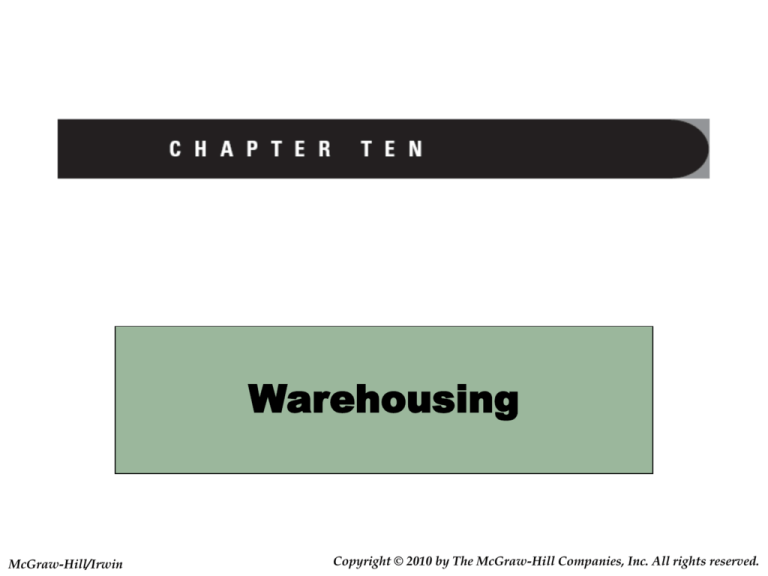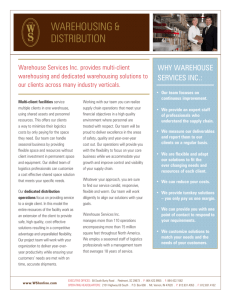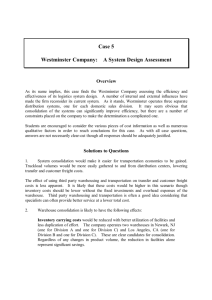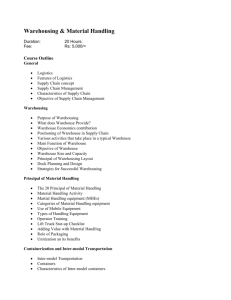
Warehousing
McGraw-Hill/Irwin
Copyright © 2010 by The McGraw-Hill Companies, Inc. All rights reserved.
Warehousing overview
• Strategic warehousing
• Warehouse operations
• Warehouse ownership
arrangements
• Warehouse decisions
10-2
Warehousing contributes value in the
logistics process
• Traditionally viewed as a
place to hold or store
inventory
• Contemporary view is the
warehouse functions to
mix inventory assortments
to meet customer
requirements
– Storage of products is held
to a minimum
10-3
Evolution of strategic warehousing
• Warehouses were once viewed
as a necessary evil, used to
coordinate product supply with
customer demand
• The explosion of the consumer
economy after WWII saw the
rise of distribution networks for
consumer goods
• Warehousing shifted from
passive storage to strategic
assortment
10-4
Warehousing types evolved to accommodate
the dynamic aspects
•
•
•
•
Distribution centers
Consolidation terminals
Break-Bulk facilities
Cross-docks
10-5
Strategic warehousing offers manufacturers a way
to reduce dwell time of parts and materials
• Warehousing is integral to justin-time (JIT) and stockless
production strategies
– Requires strategically located
warehouses across the globe
• An important goal in
warehousing is to maximize
flexibility
– Respond to ever-changing
customer demand
• Product assortments
• Value-added services
• Shipment sequencing
10-6
Strategic warehousing can provide both
economic and service benefits
• Economic benefits of warehousing occur
when overall logistics costs are reduced
–
–
–
–
Consolidation and break-bulk
Sorting
Seasonal storage
Reverse logistics
• Service benefits are justified by sales
improvements that more than offset added
cost
– Spot-stocking
– Full line stocking
– Value-added services
10-7
Consolidation and break-bulk reduce
transportation cost
• Consolidation occurs when a
warehouse receives materials from a
number of sources and combines them
into exact quantities for a specific
destination
• Break-bulk occurs when a warehouse
receives a single large shipment and
arranges for delivery to multiple
destinations
10-8
Illustration of consolidation and break-bulk
arrangements
Figure 10.1 Consolidation and Break-Bulk Arrangements
10-9
Sorting involves reconfiguring freight as it flows
from origin to destination
10-10
Cross-docking is used extensively by retailers to
replenish store inventories
• Cross-docking combines inventory from multiple origins
into a prespecified assortment for a specific customer
10-11
Successful cross-docking is highly dependent on
information technology
• Products are received,
selected, repackaged, and
loaded for shipment w/o
storage
– Used with general merchandise
& food
• Enabled by conveyors &
sortation equipment
• Used in large distribution
centers (800K to 1,200K sq.ft.)
WalMart Distribution
Center
10-12
Mixing is usually performed at an intermediate
location between origin and destination
• Mixing combines inventory from multiple origins (like
cross-docking) but also adds items that are regularly
stocked at the mixing warehouse
Stock
Inventory
10-13
Assembly supports manufacturing operations
• Assembly occurs when
products or components
from second-tier suppliers
are assembled by a
warehouse located near
manufacturing plant
• Common assembly
processes are packaging
and color customizing
10-14
Seasonal storage provides direct benefit by
accommodating production or demand
• Seasonal production
include agricultural
products
• Seasonal demand includes
lawn furniture and toys
• Seasonal storage allows
production efficiencies
within the constraints of
seasonality
10-15
Reverse logistics processing
• Reverse logistics include
activities supporting
– Returns management
• Recalls or product that did not sell
– Remanufacturing and repair
• Repairing/refurbishing equipment
– Remarketing
• Selling used equipment
– Recycling
– Disposal
10-16
Illustration of reverse logistics flow
10-17
Service benefits of warehousing
• Spot-stocking is the
positioning of inventory for
seasonal or promotional
demand
• Full line stocking provides
one-stop shopping capability
for goods from multiple
suppliers
• Value-added services include
any work that creates a greater
value for customers
Full Line Stocking at
United Electric’s
Distribution Center
– See Table 10.1 for examples
10-18
Typical list of value-added services
Table 10.1 Value-Added Services
10-19
Warehouse operations involve two major
activities – handling and storage
• Objective is to
– Efficiently receive inventory
– Store it as required
– Assemble it into complete
orders
– Make a customer shipment
• Operations will therefore
emphasize product flow
10-20
Handling
• Handling must optimize
movement continuity and
efficiency
– Receiving—Unloading the
arriving vehicles
– In-Storage—moving goods
for storage (transfer) or order
selection (picking)
– Shipping—verifying the
order and loading the
departing vehicles
10-21
Storage plans should make product velocity
a major factor
• Slotting determines
specific locations for the
product based on
– Velocity—how fast the goods
move
– Weight—how heavy is the
product
– Special Characteristics—how
large or small, does it require
rack or bin storage
10-22
Illustration of storage plan based on product
movement velocity
Figure 10.3 Storage Plan Based on Product Movement Velocity
10-23
Warehouses must manage two classes of storage
• Active Storage—storage for
basic inventory replenishment
– Focuses on quick movement
– Includes flow-through or crossdock distribution
• Extended Storage—storage
for inventory held in excess of
period for normal
replenishment
– E.g. seasonal, speculative, or
even commodities
10-24
Warehouse ownership arrangements
• Private—warehouse operated
by the firm owning the product
– Building may be owned or leased
• Public—service company owns
warehouse and hires out space
and services
– Usually classed as
•
•
•
•
•
General merchandise
Refrigerated
Bonded
Special commodity
Household goods and furniture
10-25
Contract warehousing combines elements of
private and public operations
• Usually a long-term relationship
or contract between a firm and
the warehousing owner/operator
– Long-term cost savings compared
with public warehouse
– Often a firm’s employees will work
alongside the contract warehouse’s
– Example is Kraft Foods who has
contracted with AmeriCold Logistics
since the late 1990’s
10-26
Network deployment is the combination of private,
public and contract facilities used by a firm
• Network deployment strategy
requires answering two
questions
– How many warehouses should
be established?
– Which warehouse ownership
types should be used in specific
markets?
• For example, when warehouse
utilization is not full throughout
the year
– Use private or contract
warehouse to cover 75 percent
requirement
– Public facilities used to
accommodate peak demand
10-27
Warehouse decisions that determine
handling and storage efficiency
•
•
•
•
•
•
•
•
•
•
•
Site Selection
Design
Product-Mix Analysis
Expansion
Materials Handling
Layout
Sizing
Warehouse management system
Accuracy and audit
Security
Safety and maintenance
10-28
Site selection is driven by service availability
and cost factors
• Identify broad geography where an active warehouse meets service,
economic and strategic requirements
• Selection and number of retail outlets drives location of support
warehouses
• Final selection should be preceded by extensive analysis
10-29
Illustration of straight-line product flow to
facilitate velocity
Figure 10.4 Basic Warehouse Design
10-30
Two examples illustrating the integration of
handling equipment with final layout
Figure 10.5 Layouts A and B
10-31
Warehouse management systems encourage
best practices
• Warehouse management systems (WMS) integrate
procedures and software support to standardize storage
and handling work procedures
• One main use of WMS is to coordinate order selection
– Discrete selection is when a specific customer’s order is
selected and prepared for shipment as a single work assignment
– Wave or batch selection is when orders are processed through
zones of the warehouse assigned to specific employees
10-32
Illustration of the range of activities
coordinated by an advanced WMS
Figure 10.6 Warehouse Management System Functionality
10-33
A summary of WMS functionality and
decision support benefits
Table 10.2 WMS Functionality and Decision Support
10-34
Other warehouse planning issues
• Inventory accuracy is typically
maintained by annual physical
counts or counting portions of
inventory on a planned basis
– Cycle counting is the audit of selected
inventory on a cyclic schedule
• Audits are common to maintain
safety, assure compliance to
regulations and help improve
procedures
• Security issues involve protection
from pilferage and damage
10-35
Safety and maintenance issues must also be
considered when planning warehouse designs
• Accident prevention
– Comprehensive safety programs
and training, accident
investigation and follow up
• Environmental protection
– Spill kits and spill plans
• Maintenance
– Scheduled maintenance of
building, material handling
equipment, and collision damage
prevention
10-36
What is the future of warehouse
management?
• Will warehouses grow smaller in the future?
– Offer a wider range of services?
– Will final assembly of goods be increasingly done in
warehouses?
• What is your solution to the “challenge of the last
mile” posed by Dr. Patrick Dixon?
– Video link (7:45 min.)
http://www.youtube.com/watch?v=ZbPMaxNl3J4
10-37









